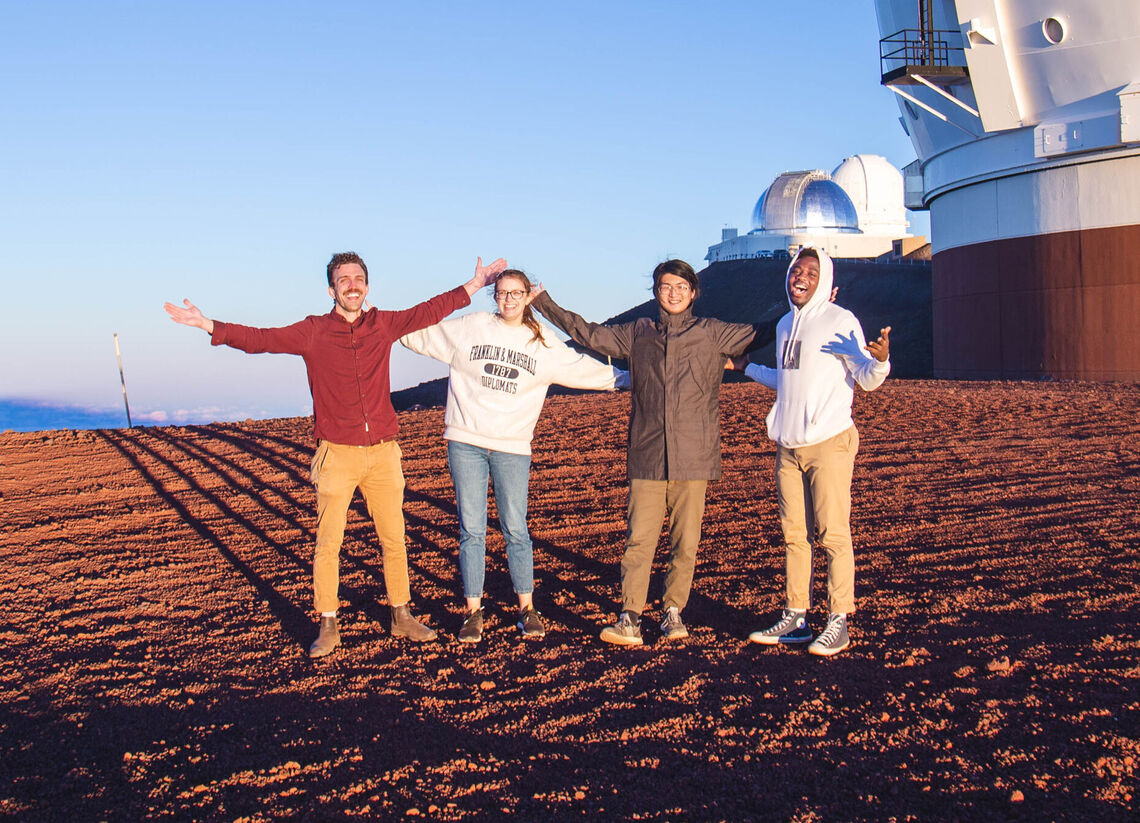F&M Stories
Students Journey to Hawaii for Extra-Galactic Research
Near the summit of Hawaii's Mauna Kea, senior Becca McClain recalled, she stood next to an observatory and marveled with her naked eye — not the lens of telescope — at the night sky.
"We watched the sun set above the clouds, and watched the stars come out in the clearest sky I have ever seen," she said. "It was the first time I ever saw the Milky Way galaxy with my own eyes, so as an astronomer, it was quite an impactful experience."
The astrophysics and mathematics double major was one of three Franklin & Marshall students who traveled to Hawaii last fall with Assistant Professor of Physics Ryan Trainor for his research related to the James Webb Space Telescope (JWST), recently launched into space, and Hawaii's W. M. Keck Observatory.
"We were using an infrared-sensitive spectrometer called MOSFIRE to measure emission from oxygen in extremely faint, distant galaxies whose light has been traveling for 11 billion years to reach us," Trainor said. "These galaxies are some of the same targets that our CECILIA program on JWST will target."
The Keck Observatory, a pair of telescopes 10 meters in diameter, are among the largest optical or near-infrared telescopes in the world. They are part of a series of 13 independent observatories on the summit, a dormant volcano and the highest peak in the state.
"Our road trip to the summit of Mauna Kea was definitely my favorite part of the trip," said senior Issac Lin, an astrophysics and mathematics double major. "I was able to get firsthand observing experience, and I shared career discussions with my mentors."
Allison Strom, a research scientist at Princeton University and primary investigator on the CECILIA program, and a doctoral student traveled with the three students and Trainor.
"All three of the F&M students are doing astrophysics research projects with me using data from the Keck telescopes, so we went out in person to help them get a better idea of where the data for their projects come from," Trainor said.
As a junior computer science major, Ojima Abraham, who until last fall had never worked in astrophysics, found the experience illuminating for his post-graduate career.
"It was exciting because I got to explore this whole new field and find its connection with my comfort zone—computer science," he said. "This exploration led to many exciting possibilities like being able to apply data analysis to astrophysics while ensuring that only the most efficient data structures and algorithms are used in the process."
Abraham is working with Trainor "on analyzing images of fainter galaxies to produce spectral energy distribution (SED) calculations and plots to better understand these fainter galaxies. The data from the Keck telescopes would provide me with more data points for my analysis as I would be able to add them to my data points for generating these SEDs."
The senior astronomers also wanted to inform students about the political and ethical issues surrounding the observatories on Mauna Kea, or Mauna Wakea', where there has been significant activism by native Hawaiians opposed to construction of a proposed telescope 30 meters in diameter.
"We visited the mountain while we were on the island in order to see the observatories, as well as to understand why Mauna Kea is so special to so many different people," Trainor said.
McClain is researching "a very massive and distant, highly ionized galaxy that has an active supermassive black hole at its center called an active galactic nucleus. The data I am analyzing comes from the MOSFIRE instrument on the Keck 1 telescope, the instrument we were observing with while we were in Hawaii."
With his project, Lin has "developed a python pipeline to produce averaged measurement of spectral features of distant galaxies based on data from Keck/MOSFIRE. My measurements on nitrogen and hydrogen emission lines assisted in determining targets of higher priority both for Keck and JWST follow-up spectroscopy."
The students say their time in Hawaii will have a lasting impact.
"The entire experience of visiting Hawaii was unforgettable," McClain said. "I learned so much about what a career in astronomy is really like, and about the many ways our work impacts the world around us."
Related Articles
May 3, 2024
Senior Spotlight: Olha Shapovalenko
A double major in mathematics and studio art, international senior Olha Shapovalenko made the most of her F&M experience. From designing theater costumes to discovering new artistic mediums, the College “enriched my creative vocabulary,” she said.
April 19, 2024
Senior Spotlight: Huaizhi Liu
Huaizhi Liu embraced new opportunities at F&M, including researching in the physics lab, being an admission tour guide, learning how to use power tools with Catastrophic Relief Alliance, and being production manager of Choomies.
April 9, 2024
Campus Celebrates Solar Eclipse
It’s not every day you catch a cosmic phenomenon between classes. F&M students did just that Monday, witnessing the country’s last total solar eclipse until 2044.

